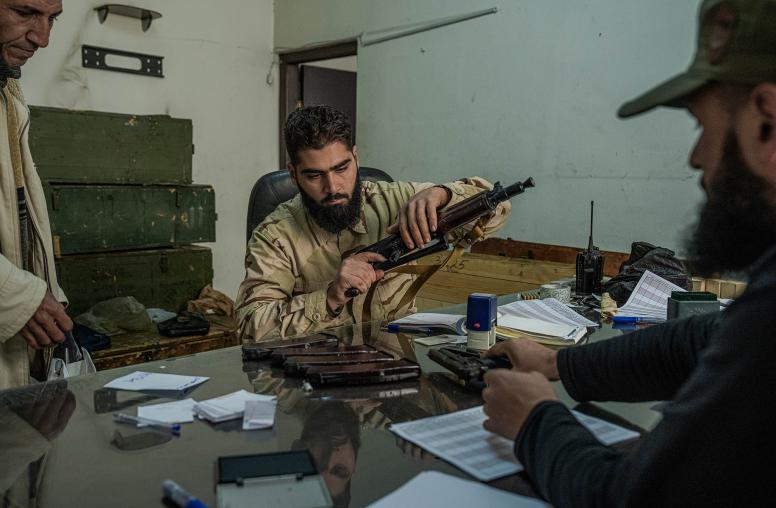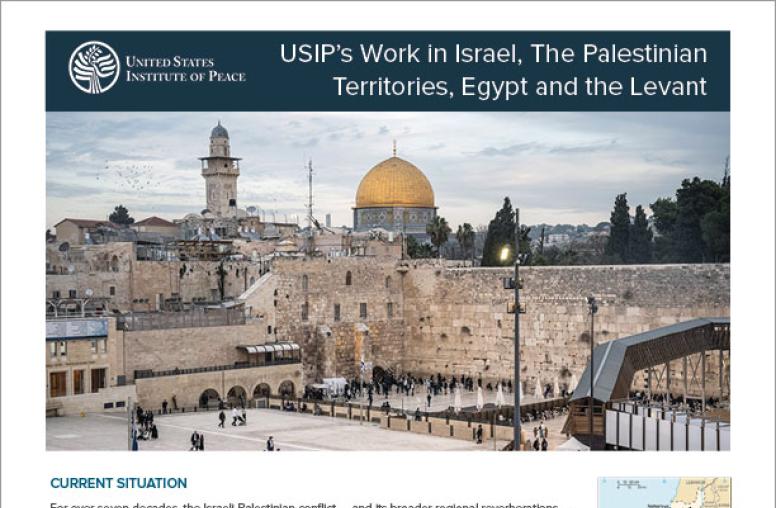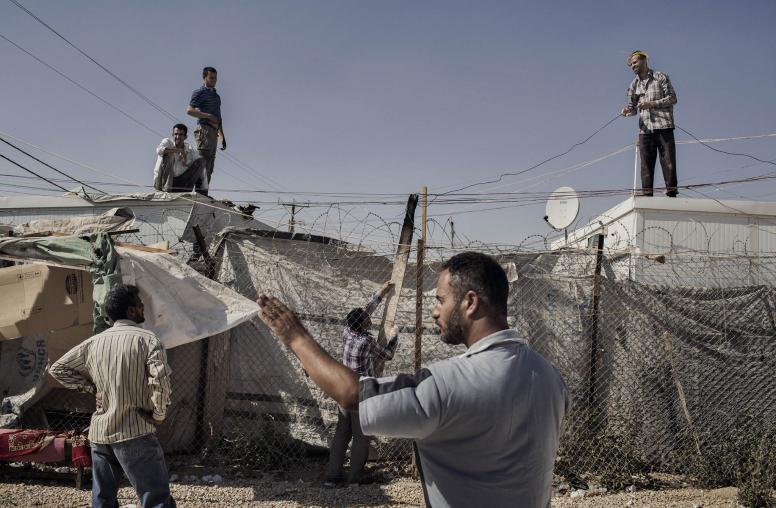The Best Hope for Sustained De-escalation in Syria
Creatively bridging the Geneva and Astana diplomatic tracks could bring greater stability and serve as a building block for a longer-term settlement.
As the conflict in Syria approaches its 10th anniversary, a holistic political settlement encompassing the entirety of the country is unlikely in the near to medium term. More than eight years of diplomatic initiatives have yielded only limited results. The two principal tracks—the Geneva and the Astana/Sochi processes—are running up against the complexity of the conflict and an emboldened Assad regime; neither process is sufficient on its own to generate momentum toward a lasting political settlement for the whole of Syria. However, creatively bridging these two processes could bring greater stability to those areas of Syria still beyond the Assad regime’s control, assuaging the suffering of some Syrians, and potentially serving as a building block for a longer-term settlement.

Barring a major strategic shift in diplomacy, developments on the ground could render both diplomatic efforts obsolete. Instead, negotiation efforts should pivot to develop innovative approaches to bridge the Geneva and Astana processes. This bridging effort would focus on consolidating fragile cease-fires in Syria’s northwest and northeast regions, and anchoring some semblance of stability in these areas through improved humanitarian access and enhancing local governance structures.
Syria’s Fragile Calm: A Frozen Conflict that is More Illusory than Real
By some accounts, the Syrian conflict could be entering a “no peace-no war” stage, marked by somewhat frozen conflict lines crisscrossing an inherently unstable country. In his October 27 briefing to the United Nations Security Council, the U.N. special envoy for Syria noted, “Frontlines … have not shifted in around 8 months. And the number of civilians killed in recent months has, according to monitoring groups, been at the lowest level since 2011.”
At the same time, Syria’s relative calm is extremely tenuous. While the current ebb in violence is notable, experience suggests that, without a more deliberate diplomatic effort to consolidate the de-escalation on the ground, conflict may erupt anew. As just one example, the fragile March 5 cease-fire negotiated between Russia and Turkey to halt a major Russian-Syrian offensive in Idlib shows serious signs of fraying. An October 26 Russian airstrike killed dozens of Turkish-backed Syrian fighters with the Faylaq as-Sham group and several civilians, the most serious violation of the cease-fire to date. This provocative Russian attack close to the Turkish border could spur a Turkish countermove. Among the more dangerous possibilities, Ankara could opt to deepen its incursion into northeast Syria. Together, this tit-for-tat escalation could lead to the rapid unravelling of the broad cessation of major hostilities that has held over both northwest and northeast Syria.
Indeed, the ongoing threat of renewed hostilities renders illusory the notion of a frozen conflict. The absence of diplomatic progress translates to a festering Syria. Lacking a definitive resolution, the Syrian conflict will continue to exact an enormous toll on civilians inside Syria, protract the crisis of Syrian refugees living in neighboring countries and the communities that host them, and compound the socioeconomic dislocation plaguing these neighboring countries in the shadow of the COVID-19 pandemic.
Seeking a “Status Quo Plus” in Syria
So, what to do? While neither Geneva nor Astana alone can effectively transform Syria’s current status quo into more enduring stability, bridging these two processes offers the best hope for sustained de-escalation until a lasting political settlement is negotiated. Yet, it is clear that such efforts will not address many of the critical challenges emanating from the Syrian conflict—particularly those centered on the Assad regime’s continued hold on power and its brutal rule over areas under its control.
However, building on common themes addressed in these parallel processes could bring about a “status quo plus” scenario on the ground that features a de facto—if not an actual—nationwide cessation of hostilities, improved humanitarian access for northwest and northeast Syria, and enhanced living conditions in these areas marked by decentralized governance, stabilization, and even early reconstruction. In the best of circumstances, these conditions could allow for the return of some Syrian refugees and internally displaced persons (IDPs) to their communities of origin where such conditions prevail.
Identify Synergies Across Northwest and Northeast Syria
Efforts to bridge Geneva and Astana could begin by identifying the similarities that increasingly characterize the northwest and the northeast. The parallels between these two regions are growing and their destinies appear increasingly intertwined.
- Both regions have fragile cessations of hostilities (COHs), which are interlinked. These COHs could be further cemented and mutually reinforced or could unravel precipitously and in a self-perpetuating downward spiral.
- External patrons play a significant role in both regions—Turkey in the northwest and the United States in the northeast, with Russia exerting influence in both areas. Yet, for the most part, these external actors do not engage simultaneously in the same process to mediate tensions within or across the two regions. The endgame for these external actors remains muddled in both regions and therefore potentially open to reinterpretation and compromise.
- Both regions are largely under the control of proscribed groups (Hayat Tahrir as-Sham [HTS] in the northwest and Syrian Kurdish elements with ties to the Kurdistan Workers’ Party [PKK] in the northeast) who appear to be seeking greater accommodation and legitimacy with external actors and the international community writ large. Interestingly, in both cases, decisions by each group to embrace greater “Syrianization” could facilitate wider acceptance on the ground and beyond. Both groups are also currently excluded from ongoing peace processes, despite wielding effective control over large swathes of territory and populations that include at least three million civilians.
- Both regions feature relatively autonomous, decentralized governance that affords local populations some degree of autonomy, although many issues and challenges remain. Nonetheless, these models of decentralized governance could feed into a blueprint for a future Syria.
Developing a Geneva–Astana Bridging Strategy via Northwest and Northeast Syria
Exploiting the synergies embedded in these overlapping dynamics and the intertwined fates of northwest and northeast Syria offers the most viable path forward on the ground to bridging Geneva and Astana. Essentially, these two regions hold the greatest potential for innovative engagement across multiple stakeholders to develop enduring de-escalation mechanisms. While the Assad regime typically delays and obstructs efforts connected to Syrian peace processes (stalled efforts on the Constitutional Committee being just one example), its lack of effective control in northwest and northeast Syria allows potential pathways forward to be imagined. A diplomatic effort to bridge Geneva and Astana via these two regions could facilitate more sustained de-escalation and local-level development in these areas of Syria—whose population together comprises some six million civilians—in the long interregnum before a lasting political settlement is negotiated.
The United Nations could play a key role in surfacing the unexplored synergies across these regions, ideally finding a way forward in the absence of a clear political settlement for all of Syria. By developing a greater understanding of these parallels and the dynamic interplay between them, it might be possible to unlock a more constructive and stable approach to a “no peace-no war” Syria.
To get to this desired medium-term endpoint of “status quo plus,” all players will need to make concessions on what is tolerable, although not ideal for each. Via intensified diplomacy, the United Nations special envoy could take the lead in gaining greater clarity on the endgames and potential points of compromise, trade-offs, and unrealized win-win synergies among key stakeholders in the northwest and the northeast. This would include exploring paths toward moderation by proscribed groups in control on the ground and modified endgames for external stakeholders. Although short of a nationwide political settlement, arriving at a “least common denominator” solution in these areas could lead to a medium-term stable outcome for Syria.
Challenges of a Northwest-Northeast Bridging Strategy
This northwest-northeast bridging strategy is far from perfect and entails clear challenges and downsides, which must be mitigated as much as possible. First, the strategy risks entrenching a de facto partition of the country into three separate areas: regime-held Syria, the northwest, and the northeast. Second, to be implemented, a northwest–northeast bridging strategy is likely to require the long-term, small footprint presence of foreign forces currently on the ground in these areas. The strategy does not address the Assad regime’s brutal practices in areas under its control, including arbitrary detentions, forced disappearances, and torture. Nor does it address the mounting human rights concerns in the Afrin, Ras al-Ayn, and Tel Abyad regions controlled by Turkish-backed forces.
Finally, this strategy could be undone by the complicated fallout from other regional conflicts. The Syrian conflict zone is increasingly enmeshed in an expanding series of interlinked conflicts stretching from Libya to Nagorno-Karabakh. Reflective of wider regional and global disorder, these overlapping conflicts often reverberate across geographic zones, introducing potential “wild card” elements into the already complex Syrian conflict. For example, Russian and Turkish competition in Libya and Nagorno-Karabakh has echoed into the Syrian arena with destabilizing effects.
Damascus-centered peace negotiations show little—if any—sign of progress. To date, the Assad regime has shown itself to be largely impervious to pressure, slow at rolling out even the most cosmetic reforms, while doubling down on brutal tactics wherever it can. With lasting peace across Syria still a distant prospect, a creative bridging of the Geneva and Astana processes via a northwest–northeast strategy could serve as an innovative approach towards de-escalation that lessens the suffering of ordinary Syrians and potentially lays the groundwork for a future settlement. Otherwise, Syria’s fragile calm is unlikely to last.
This analysis was originally published as part of the Geneva Centre for Security Policy’s “Syria Transition Challenges Project.”


